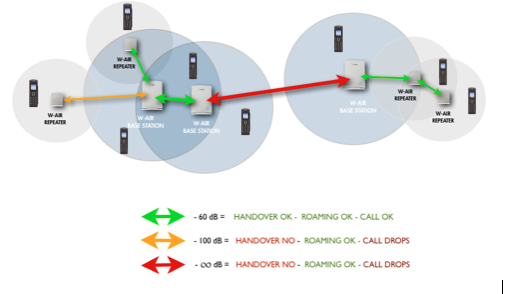| Scroll export button | ||||||||
|---|---|---|---|---|---|---|---|---|
|
| Info |
|---|
This guide leads you through the installation of W-AIR Base and W-AIR Base Outdoor and setting up a W-AIR DECT Network in which the bases sync over the air. Updated: February 2022 Permalink: https://wildix.atlassian.net/wiki/x/SwrOAQ |
| Info |
|---|
W-AIR Base is End Of Life. |
| Table of Contents |
|---|
Watch the video tutorial about setting up W-AIR Multicell Network (registration is required):
...
- Multicell base stations: W-AIR Base (End Of Life), W-AIR Base Outdoor, W-AIR Base Sync Plus, W-AIR Base Sync Plus Outdoor (for sync over LAN, refer to W-AIR Network Admin Guide - Sync over LAN)
- Single Cell base station: W-AIR Base Small Business. Documentation Documentation: W-AIR Small Business - Admin Guide, W-AIR Small Business R1 OLD - Admin Guide/wiki/spaces/DOC/pages/30279971
2. Repeater - extends the signal coverage of the base station.
3. Cordless endpoints:
Wildix W-AIR handsets: W-AIR Basic (ex W-AIR 70)Basic2, W-AIR 100 (End Of Life), W-AIR LifeSaver (ex W-AIR 150), W-AIR Med, W-AIR Office and W-AIR Headset. Follow the online Guides to get detailed information: W-AIR DECT Handset - User Guide, W-AIR Headset - User Guide.
...
- Up to 1000 users per system
- Up to 250 bases
- Up to 30 handsets registered to one base station*
- Up to 3 Repeaters per base
- Up to 50 bases - 3 repeaters
- 50-125 bases - 1 repeater
- More than 125 bases - no repeater
- Up to 100 Repeaters registered to one system
- Up to 8 concurrent calls** per base
- 8 narrow band audio channels per base
- 4 CAT-iq wideband audio channels per base
- (Single cell setup) Max 10 concurrent calls per base
- Handover through the base station (max. 8 simultaneous handovers)
- Up to 5 concurrent calls per repeater
- Up to 24 sync levels
- Base station indoor range: 50 m; outdoor range: 300m
| Note |
|---|
*Note: by default W-AIR system supports up to 20 devices, to increase the number to 30 devices, use Custom Provisioning parameter, described in this document: Provisioning Custom Settings. |
| Warning |
|---|
** Enabling PTT feature (Push-to-talk) on W-AIR handsets reduces the number of available channels on each base station to 6. |
Planning a multicell network
Before you start
| Warning |
|---|
Important:
|
Intelligent Networking Configuration:
...
Base Station and Repeater positioning:
| Warning |
|---|
For a good conversation and a correct handover between Bases and Repeaters the dBm value must be between -75 and 0. |
Handover and Roaming
Handover
...
- Go to the WMS menu Devices → W-AIR Networks → click Add
- Enter the name Name for your W-AIR Network
Select the gateways from the list on the left and move them to the list on the right
Warning Limitation: it is impossible to register a W-AIR Headset if the code of W-AIR network is different from "0000" (default code). Workaround: temporarily change the code to default one ("0000") , register and assign the Headset(s), and then change it back to custom one.
Click “Save”
Note The first base becomes the Main base of the network (M). The gateways make radio sync over the air with each other automatically to extend the work range if possible.
- Go back to the Devices Menu, select your base/bases and press “Configure/ Sync device” button
| Warning |
|---|
For CLOUD PBXs, you need to power off the base station and then power it on again (reboot the base station) to apply the new parameters! |
Step 3. Register a W-AIR Handset
...
The sync chain must always overlap with other Base stations in order to latch each other in sync.
Primary base is the one that performs the sync.
A maximum of 24 sync levels (Including the primary base) can be used in a deployment.
Secondary base stations or repeaters are connected to the Primary base through the synchronisation chain
If one of the base or repeater units in the sync chain is broken or not working, then the units that follow the non-working device are cut off from the sync chain, and sync can be lost. In this case, handover between the two clusters is not possible.
...
A maximum of 250 base stations can be deployed in one setup (depending on the network requirement not all base stations should be chained).
A maximum of 24 sync levels can be used in any deployment.
Depending on the system setup, it is recommended to place the Primary base station in the middle of the building and to assign numbers/addresses, radio ID (RPN), etc. to each base station or repeater for easy identification.
Continuous line: Shows the primary sync paths, with the relevant bases chained in the multicell network.
Dotted line: Alternative sync paths.
...

